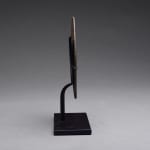Sassanian Bronze Mirror, 300 CE - 700 CE
Bronze
height 11.7 cm
height 4 5/8 in
height 4 5/8 in
FZ.434
Further images
In 244 A.D., Ardeshir I founded the Sassanid Dynasty, the last native Persian Kingdom to rule Ancient Iran before the Islamic conquest. The Sassanid era was a golden age of...
In 244 A.D., Ardeshir I founded the Sassanid Dynasty, the last native Persian Kingdom to rule Ancient Iran before the Islamic conquest. The Sassanid era was a golden age of Persian culture that witnessed the revival of Zoroastrianism, an ancient mystical religion native to these lands, and a literary Renaissance spurred by the translation of many Old Persian epics recorded in cuneiform into the Middle Persian language of Pahlavi written in an alphabet derived from Aramaic. By introducing heightened international trade and commerce they created a legacy of political and economic diplomacy. They sponsored trade with the Romans (later on the Byzantines), their archenemy, to the west and the Chinese to the east. Excavations in China have unearthed gold and silver Sassanid coins covering a span of many centuries until the demise of the Empire during the reign of Khosrow II. However, the fall of the Empire had already started with a series of wars waged under the rule of Khosrow I, the father of Khosrow II. Challenged by the intensification of the same international commerce that had bore such wealth, struggles for national power and international prestige had escalated to an ungovernable degree. In the face of threats to his royal house, Khosrow II embarked upon military campaigns that would prove unsuccessful. By the close of his reign, the once mighty Sassanid Empire came to an end, paving the way for the rise of Islam in the Middle East.
Standing triumphantly upon the body of a slain lion, holding two more defeated beasts in his outstretched arms, a king is represented on the back of this bronze mirror. Bearded, with ominous eyes, the king wears the corrugated, flaring crown that is the symbol of Sassanid authority and the baggy pants that were the traditional dress of the region since the time of the Achaemenids. Such imagery might be related to the Luristan bronze finial sculptures created over a millennium earlier. These highly stylized works depict an individual, perhaps a god or a king, holding two fearsome monsters in his hands. This subject matter is today known as the “Master of the Beasts,” and clearly, this Sassanid mirror echoes such pieces. Originally, the front of this mirror that is now encrusted with a thick patina, a testament to the works age, would have been finely polished so that a Sassanid princess or prince would have been able to admire their own appearance. This ancient mirror is a testament to mankind endless quest to be surrounded by beautiful works of the highest quality craftsmanship, as well as our pursuit to make ourselves more beautiful.
Standing triumphantly upon the body of a slain lion, holding two more defeated beasts in his outstretched arms, a king is represented on the back of this bronze mirror. Bearded, with ominous eyes, the king wears the corrugated, flaring crown that is the symbol of Sassanid authority and the baggy pants that were the traditional dress of the region since the time of the Achaemenids. Such imagery might be related to the Luristan bronze finial sculptures created over a millennium earlier. These highly stylized works depict an individual, perhaps a god or a king, holding two fearsome monsters in his hands. This subject matter is today known as the “Master of the Beasts,” and clearly, this Sassanid mirror echoes such pieces. Originally, the front of this mirror that is now encrusted with a thick patina, a testament to the works age, would have been finely polished so that a Sassanid princess or prince would have been able to admire their own appearance. This ancient mirror is a testament to mankind endless quest to be surrounded by beautiful works of the highest quality craftsmanship, as well as our pursuit to make ourselves more beautiful.







